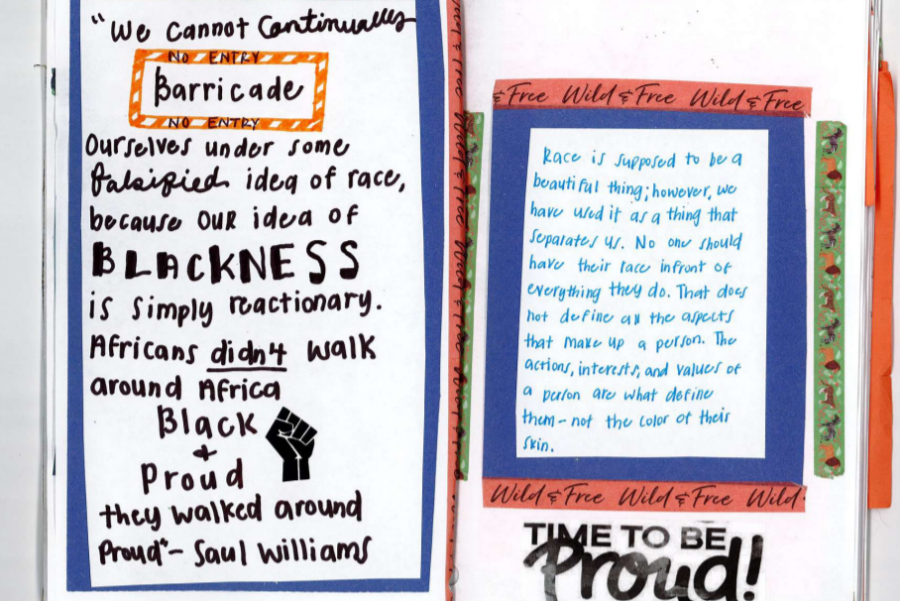Zines provide low-cost avenue for Black voices
Photo courtesy of Jaleah Patton
A page from Jaleah Patton’s zine, “Black Enough: Not too much and definitely not too little”. Zines are an inexpensive outlet for underrepresented views and voices.
January 19, 2022
What is a zine (pronounced ZEEN)?
Zines are safe and powerful outlets for underrepresented and marginalized voices. Historically, zines have served as a powerful medium to communicate personal or political views that are often too niche or not represented in mainstream media.
Traditionally, zines are easily reproduced by taking the original “master flat,” mass-producing copies, folding them and then stapling them into tiny booklets and pamphlets.
There is no one format for a zine. They may be bound, unbound, stapled, glued or sewn. They are rather inexpensive to produce depending on their content and intended length.
One of the important aspects of zines is that the publication or publisher identifies them as one. When a publication identifies as a zine, they distinguish themselves from journals, websites, comics and other publications. Many zine-makers feel that the community is just as important as the products and ideas. Not only that, but the method of distribution helped create a sense of unity by connecting artists with their audience.
Get The Daily Illini in your inbox!
Another important aspect that distinguishes zines from other publications is the passion of the creator. The intent for a zine’s publication is typically not for profit, they are motivated by self-expression.
Zines and other small-scale publishers are important as they ensure that underrepresented voices are heard, recognized and recorded. This type of independent publishing is vital as it is dedicated to its artist’s voices and not motivated to appeal to the mainstream audience. Most material that is released by top publishing houses is from exclusive artists and voices and content that appeals to mainstream tastes.
The word “zine” is a short term for “fanzine,” a term coined by science fiction fans in the 1930s to describe fan magazines about various cultural phenomenons. One of the first publications of zines started from the Science Correspondence Club in Chicago, Illinois, called “The Comet.”
Historically, zines have provided perspectives from voices that have been filtered or silenced.
Zines like “Black Dialogue,”Black on Black,” “We Called a Strike” and more, for example, provide personal narratives during the civil rights movement.
They also became popular for spreading political messages in the 1960s. “Journal of Black Poetry” and “We Called a Strike and No One Came” by Black and Red were zines that gave readers a look into the lives of Black people from an unfiltered view through a creative way that was easily digestible.
By the ‘70s, zines were easier than ever to make. Thanks to the rise of copy shops, zine-makers were able to produce their work more efficiently. Previously, they had been created using mimeographs – using ink and stencils to produce prints – but this process was ineffective for mass production.
Later, the popularity of zines began to become a part of a variety of different scenes – art, sci-fi, punk, music, political, personal thought/commentary and more.
Publications like Punk and Sniffin’ Glue were some of the prevalent editions in punk culture in the ‘70s and ‘80s. With punk music deeply rooted in being anti-establishment, the DIY and self-distribution of zine culture blended well.
Zines became popular again during the early 1990s by underground feminist punk movements. One popular publication was “Riot grrrl,” which used zines as a platform for women to openly express their opinions on issues like sexual abuse, stereotypes, body image and more.
Zines have diversified representation throughout history and given a platform to contributions from marginalized groups. They helped push inclusivity and a variety of unfiltered perspectives.
With computers and the internet, the cost of zine creation is nearly zero. Not only that, but it is easier than ever to find those communities and connect with people no matter the location. There are zines on any subject, reflected today with zine collections and independent zine libraries.
Again, there are no set rules for how to create one, the content and appearance are entirely up to the creator. They can be incredible resources for activists, artists, writers and all types of people.







